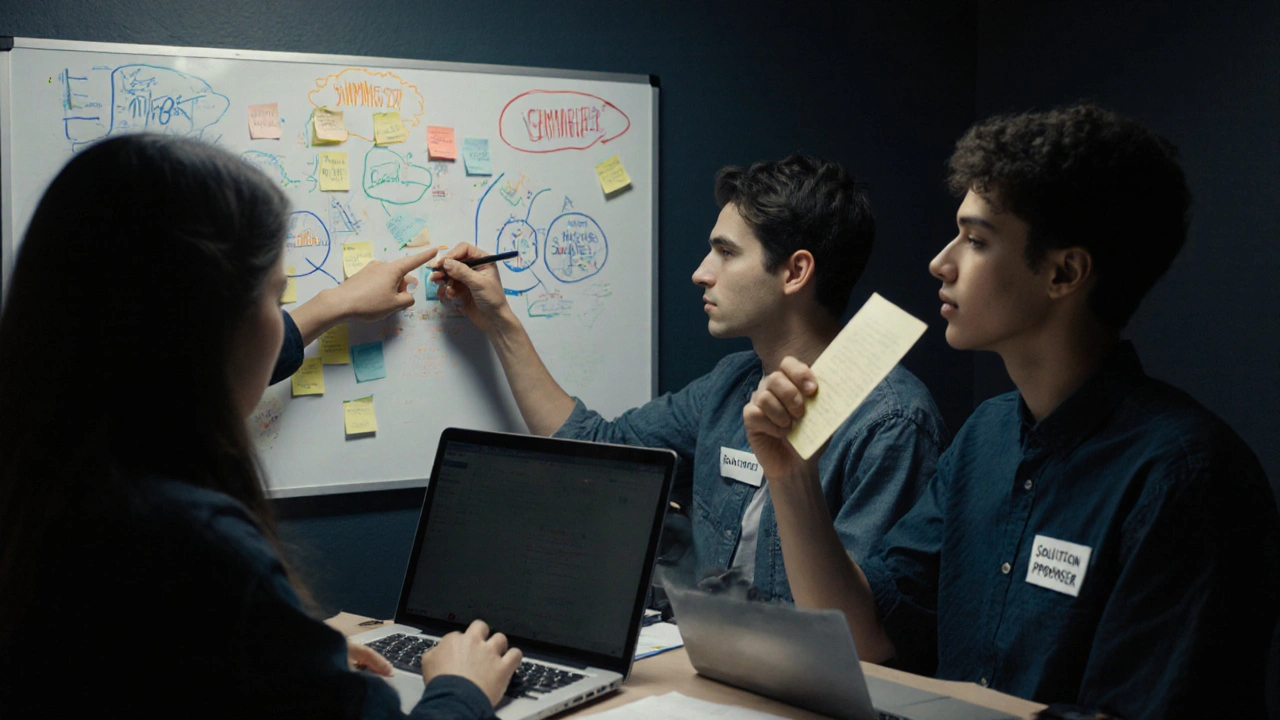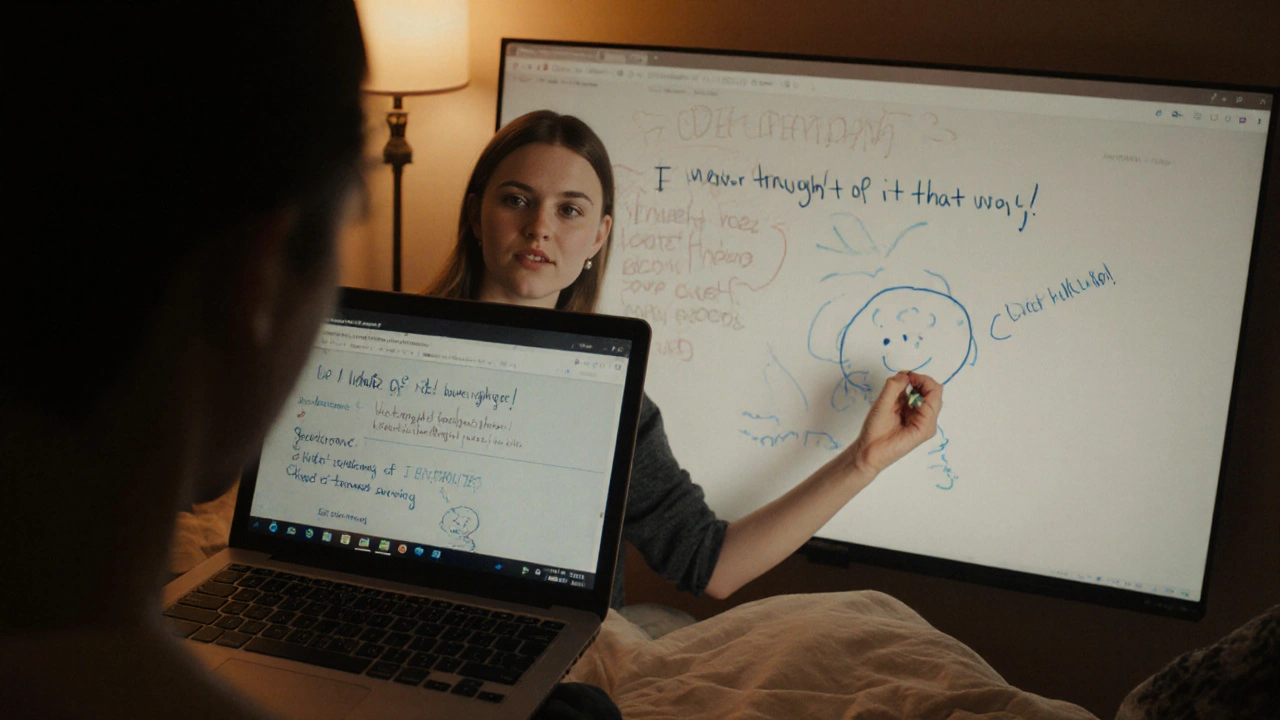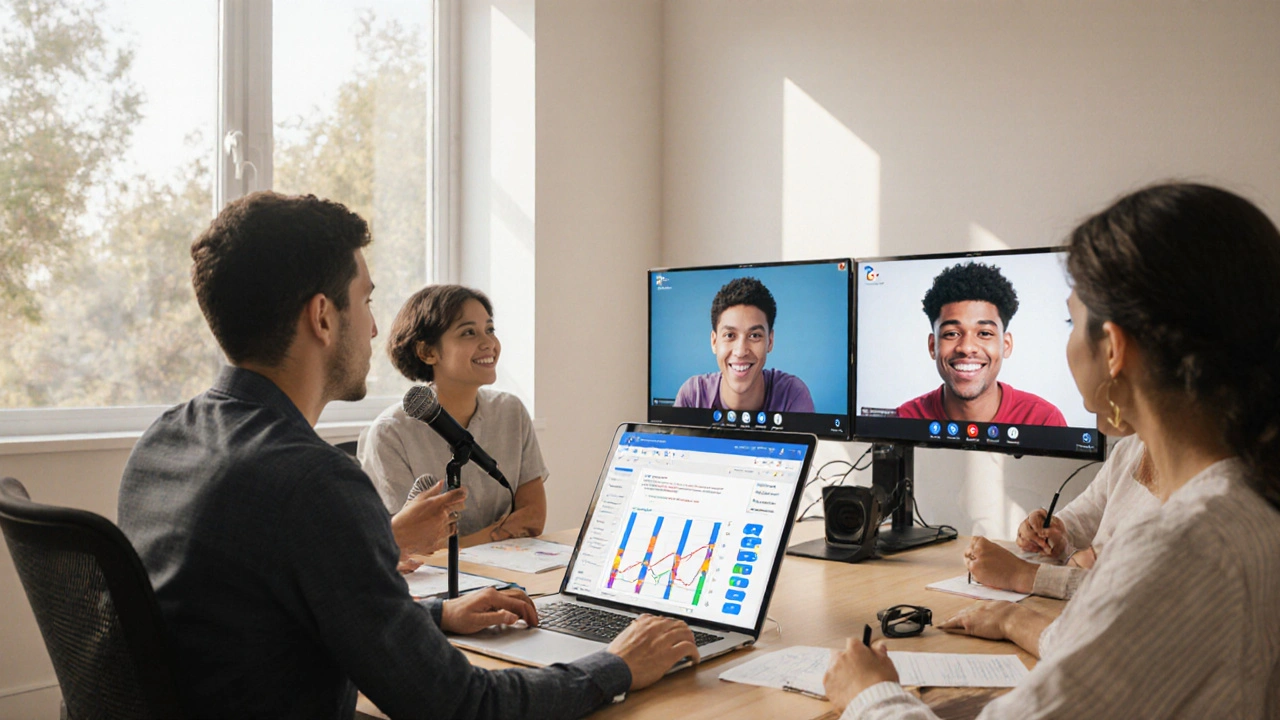When you teach online, it’s easy to fall into the trap of lecturing into a camera while students mute themselves and disappear behind their screens. You’re not alone. Many instructors feel like they’re talking to a wall. But the real problem isn’t the technology-it’s the lack of active learning. Passive video lectures don’t stick. Students forget. They disengage. And by week three, attendance drops and participation vanishes.
Why Passive Lectures Fail in Online Classes
Think about your own experience as a student. Did you remember that hour-long lecture on supply chain theory from your college days? Probably not. Now think about the time you had to solve a real problem in a group, explain your idea out loud, or build something with your hands. That’s what sticks. The brain learns by doing, not by listening.
Online classes amplify this problem. Without physical presence, students don’t feel accountable. They can turn off their cameras, open another tab, or even leave the room. If your class is just videos and PDFs, you’re not teaching-you’re broadcasting.
Active learning flips this. It puts students in the driver’s seat. They’re not just receiving information-they’re processing it, applying it, arguing over it, and teaching it back to others. And the best part? It works-even in Zoom rooms.
Strategy 1: Start with a Quick Poll, Not a Lecture
Don’t open your class with a 10-minute monologue. Start with a poll. Use tools like Mentimeter, Slido, or even a simple Google Form. Ask something like: “What’s the biggest challenge you’ve faced with remote teamwork?” or “Which part of this reading confused you the most?”
This does three things:
- It wakes up the brain-students know they’ll have to respond.
- It gives you real-time data on where students are struggling.
- It shows students their voice matters.
One instructor at a community college in Ohio used this method in her online sociology course. Instead of lecturing on social norms, she asked students to share a time they broke an unspoken rule. Over 90% responded. The discussion that followed was richer than any lecture she’d ever given.
Strategy 2: Use Breakout Rooms Like a Pro
Breakout rooms aren’t just for icebreakers. They’re your most powerful tool for active learning. But most instructors use them wrong. They say: “Go into breakout rooms and discuss this question,” then disappear for 10 minutes.
That’s a recipe for silence. Instead, give students a clear task with a structure:
- “In your group of three, pick one example from the case study. One person summarizes it. One person identifies the key problem. One person proposes a solution. You have 7 minutes.”
Assign roles. Set a timer. Ask each group to share one insight when they come back. This forces participation. No one can hide.
At the University of Auckland, a business professor used this method for a negotiation simulation. Students were assigned roles as buyer, seller, and mediator. They had 12 minutes to reach an agreement. The results? 87% of students said they understood the concepts better than in any in-person class.

Strategy 3: Make Them Teach Each Other
The best way to learn something is to teach it. That’s the Feynman Technique-and it works wonders online.
Assign each student a short concept from the week’s material. Give them 48 hours to create a 3-minute video explaining it in plain language. No slides. No jargon. Just them talking to the camera like they’re explaining it to a friend.
Then, have them post it in a shared folder. Everyone watches three videos from peers and leaves one comment: “What surprised you?” or “What part was still unclear?”
This turns passive learners into active teachers. It also builds empathy-students see how hard it is to explain something clearly. One student in a psychology course said: “I thought I understood cognitive dissonance until I tried to explain it without using the word ‘dissonance.’”
Strategy 4: Build Real-Time Problem Solving
Instead of giving students a worksheet to complete alone, give them a messy, real-world problem to solve together. Use shared documents-Google Docs, Miro boards, Notion spaces-where everyone can contribute at the same time.
For example:
- In a writing class: “Edit this paragraph as a group. You have 10 minutes. Only one person can type at a time. You must agree on every change.”
- In a science class: “Here’s a dataset with missing values. Figure out what’s wrong and propose a fix.”
- In a history class: “You’re a town council in 1920. This new law just passed. Who benefits? Who loses? What’s your next move?”
When students are solving something real-not just answering multiple-choice questions-they’re thinking critically. They’re negotiating, justifying, and adapting. That’s learning.
Strategy 5: End Every Class with a One-Minute Paper
Don’t just say “Any questions?” and wait for silence. End every session with a quick, anonymous written reflection.
Ask: “What’s one thing you learned today?” and “What’s one thing that’s still confusing?” Use a simple form or a chat box. Collect them. Read them. And start the next class by addressing the top two confusions.
This does two things: it gives you feedback you can actually use, and it tells students: “I’m listening.”
A high school teacher in Texas started doing this in her online AP Biology class. Within three weeks, her student retention jumped from 68% to 94%. Why? Because students knew their confusion mattered. They weren’t just being graded-they were being heard.

What Doesn’t Work (And Why)
Not all “interactive” tools are active learning. Here’s what to avoid:
- Just using polls without follow-up: If you ask a poll and never mention the results, students feel ignored.
- Forcing camera-on policies: It doesn’t improve engagement-it creates anxiety. Focus on participation, not presence.
- Assigning group projects with no structure: Without clear roles and deadlines, one person ends up doing all the work.
- Using discussion boards as a substitute for live interaction: Threads get buried. Responses are shallow. Real-time dialogue is irreplaceable.
Active learning isn’t about adding more tech. It’s about designing moments where students have to think, speak, and act.
How to Start Small
You don’t need to overhaul your whole course. Pick one strategy and try it next week.
Here’s a simple plan:
- Next class, start with a poll.
- Use breakout rooms with a clear task (roles + timer).
- End with a one-minute paper.
Do that for three weeks. Then check your student feedback. You’ll likely see a jump in participation, fewer dropouts, and more thoughtful responses.
One instructor in New Zealand told me: “I used to dread teaching online. Now I look forward to it. My students are actually excited to show up.”
That’s the power of active learning. It doesn’t require fancy software. It just requires you to stop talking long enough for students to start thinking.
What’s the difference between active learning and regular online lectures?
Regular online lectures are one-way: the instructor talks, students listen. Active learning requires students to do something-solve a problem, explain an idea, debate a point, or create something. It’s not about watching content; it’s about using it. Studies show students retain 70% more when they actively engage with material compared to passive listening.
Do I need special software for active learning in online classes?
No. You can do active learning with basic tools. Google Forms for polls, Zoom breakout rooms, shared Google Docs, and even chat boxes work perfectly. The tech is just a tool-the real change is in how you design the activity. Focus on structure, timing, and clear tasks, not fancy apps.
How do I handle shy or quiet students in active learning?
Shy students often thrive in small-group settings with clear roles. Instead of calling on them publicly, assign them a specific job-like “note-taker” or “timekeeper”-in breakout rooms. Give them time to write responses before sharing. Use anonymous polls or one-minute papers so they can contribute without speaking up. Progress, not perfection, is the goal.
Can active learning work in large online classes?
Yes, but you need to scale the structure. For classes over 50 students, use peer review systems, automated polling, and structured discussion boards with prompts. Assign small groups to analyze different case studies, then have each group summarize their findings in a shared document. The key is to break large groups into manageable chunks with clear outcomes.
How do I know if active learning is actually working?
Look for signs: more students showing up on time, fewer “I didn’t understand” emails, richer discussion threads, and students asking follow-up questions. Track participation rates and compare them to previous semesters. Student feedback surveys often reveal deeper understanding-like when they say, “I finally get it because I had to explain it to someone else.”
Final Thought: Teaching Is Not Broadcasting
Online teaching isn’t about recording perfect videos. It’s about creating space for thinking, talking, and doing. The most effective online instructors aren’t the ones with the best lighting or the most slides. They’re the ones who design moments where students can’t just sit back-they have to step up.
Start small. Stay consistent. Listen to your students. And remember: the goal isn’t to fill their heads with information. It’s to help them build something inside their minds that lasts.


Comments
Rohit Sen
Active learning? Sounds like a buzzword for professors who can't hold attention. I've taken 12 online courses. Only one had real engagement. Guess what? It was a guy who just talked like a human, not a TED Talk script.
Vimal Kumar
I tried the one-minute paper in my stats class last semester. Students who never spoke up started sharing real confusion in those little notes. One kid wrote 'I don't get standard deviation but I know I'm bad at budgeting' - and suddenly the whole class got it. No tech needed. Just space to breathe.
Amit Umarani
There’s a comma missing after 'Zoom rooms' in Strategy 1. Also, 'Mentimeter' is capitalized inconsistently. And you say 'students forget' - but forget what exactly? The content? The feeling? The time? Precision matters. This piece reads like a blog draft, not a pedagogical guide.
Noel Dhiraj
Start with a poll. That's it. That's the whole secret. I used to lecture for 45 minutes. Now I ask one question. Students reply. We talk. I don't even need breakout rooms. Just listen. They'll tell you what they need. And yeah, it works. Even in rural India with spotty internet.
vidhi patel
It is imperative to note that the term 'active learning' is frequently misappropriated by educators lacking pedagogical training. The methodology you describe is merely structured interaction, not active learning per se. Furthermore, the statistical claims regarding retention rates lack citation and are therefore empirically unsound. I urge you to revise this piece with academic rigor.
Priti Yadav
They're watching you. The university is tracking your breakout room participation. They're using this to grade your 'engagement score' and sell it to edtech companies. That 'one-minute paper'? It's data mining disguised as feedback. They don't care if you learn. They care if you click.
Ajit Kumar
Let me be perfectly clear: the notion that passive lectures are inherently ineffective is a gross oversimplification rooted in a fundamental misunderstanding of cognitive load theory. The human brain requires periods of receptive silence to consolidate information; constant activity induces cognitive fatigue, not retention. Furthermore, your assertion that students 'forget' lectures ignores the longitudinal nature of knowledge acquisition. I have taught for 22 years, and I can tell you that the most profound learning often occurs weeks after the lecture, when the student revisits the material in solitude. Your methods may produce immediate engagement, but they do not guarantee deep understanding. You are trading depth for spectacle.
Diwakar Pandey
I use breakout rooms but I never check in. I just set the timer and let them go. Sometimes they talk. Sometimes they don't. But when they do, it's real. One kid told his group he was working two jobs and couldn't sleep. That wasn't in the syllabus. That's when teaching becomes human.
Geet Ramchandani
This is the same tired playbook every year. Polls, breakout rooms, one-minute papers - it's all theater. The real problem? Students don't care. They're paying for a degree, not an experience. You think they're going to write a 3-minute video explaining cognitive dissonance? They'll use ChatGPT in 30 seconds and copy-paste. Your 'active learning' is just a way to make teachers feel better about being replaced by algorithms. Wake up.
Pooja Kalra
There is a metaphysical dimension to learning that your framework ignores. To 'do' is to externalize; to 'be' is to internalize. The soul does not learn through tasks or roles. It learns through silence, through the space between thought and expression. You mistake motion for meaning. The student who watches a lecture in stillness may be more profoundly transformed than the one who shouts into a breakout room.
Sumit SM
Let me tell you something - I tried the Feynman Technique with my nephew, he's 17, and he made a video explaining photosynthesis using a banana and a flashlight - and then he actually asked me if plants get tired. That’s when I knew - this isn’t about pedagogy, this is about wonder. We’ve lost wonder in education. You’re not teaching content - you’re reigniting curiosity. And that’s the only thing that lasts. I’m not a teacher. I’m a witness. And I’ve seen it happen. It’s beautiful. Don’t overthink it. Just let them talk.